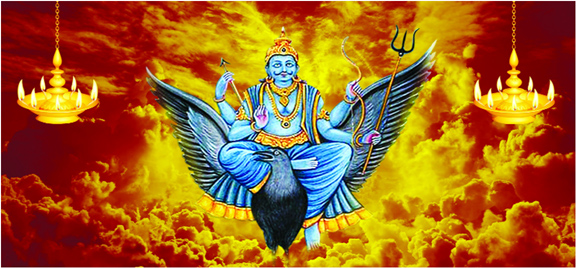
Shani Bhagwan (also known as Sani, Shani Dev, Sani Maharaj, and Chayyaputra) is one of the most popular deities in the traditional religion of Hinduism. Shani is the harbinger of bad luck and retribution, and practicing Hindus pray to Shani to ward off evil and remove personal obstacles. The name Shani comes from the root Sanaischara, meaning slow mover (in Sanskrit, “Shani” means “the planet Saturn” and “chara” means “movement”); and Shanivara is the Hindu name for Saturday, which is dedicated to Shani Baghwan.
Significant epithets for Shani include Saura (son of the sun god), Kruradris or Kruralochana (the cruel-eyed), Mandu (dull and slow), Pangu (disabled), Septarchi (seven-eyed), and Asita (dark).
Shani in Images
In Hindu iconography, Shani is portrayed as a black figure riding in a chariot that moves slowly through the heavens. He carries various weapons, such as a sword, a bow and two arrows, an ax, and/or a trident, and he is sometimes mounted on a vulture or crow. Often wearing dark blue or black clothing, he carries a blue flower and sapphire.
Shani is sometimes shown as lame or with a limp, a result of fighting with his brother Yama as a child. In Vedic astrology terminology, Shani’s nature is Vata, or airy; his gem is a blue sapphire and any black stones, and his metal is lead. His direction is west, and Saturday is his day. Shani is said to be an incarnation of Vishnu, who gave him the task of granting to Hindus the fruits of their karmic nature.
Origins of Shani
Shani is the son of Surya, the Hindu sun god, and Chaya (“Shade”), a servant of Surya who acted as surrogate mother for Surya’s wife Swarna. While Shani was in Chaya’s womb, she fasted and sat under the hot sun to impress Shiva, who intervened and nurtured Shani. As a result, Shani turned black in the womb, which is said to have enraged his father, Surya.
When Shani opened his eyes as a baby for the very first time, the sun went into an eclipse: that is Shani turning his father (temporarily) black in a rage of his own.
The elder brother of the Hindu god of death, Yama, Shani delivers justice while a person is alive and Yama serves justice after a person’s death. Among Shani’s other relatives are his sisters—the goddess Kali, destroyer of evil forces, and the goddess of the hunt Putri Bhadra. Shiva, married to Kali, is both his brother-in-law and his guru.
Lord of Bad Luck
While often considered cruel and easily enraged, Shani Baghwan is both the greatest troublemaker and the greatest well-wisher, a strict but beneficent god. He is the god of justice who oversees the “dungeons of the human heart and the dangers that lurk there.”
Shani Baghwan is said to be very harmful to those who betray, backstab, and seek unjust revenge, as well as those who are vain and arrogant. He makes people suffer for their sins, so as to purify and cleanse them of the negative influences of evil they have acquired.
In Hindu (also known as Vedic) astrology, the planetary position at the time of one’s birth determines his or her future; anyone born under Shani’s planet Saturn is believed to be at risk for accidents, sudden failures, and money and health problems. Shani asks that Hindus live in the moment, and predicts success only through discipline, hard work, and struggle. A worshipper who practices good karma can overcome the difficulties of an ill-chosen birth.
Shani and Saturn
In Vedic astrology, Shani is one of the nine planetary deities called the Navagraha. Each of the deities (Sun, Moon, Mars, Mercury, Jupiter, Venus, and Saturn) highlights a different face of destiny: Shani’s destiny is karmic, to make individuals pay for or benefit from the evil or good they do during their lifetime.
Astrologically, the planet Saturn is the slowest of the planets, remaining in a given Zodiac sign for about two and a half years. Saturn’s most powerful place in the Zodiac is in the seventh house; he is beneficial to Taurus and Libra ascendants.
Saade Sati
The propitiation of Shani is required of every single person, not just those born under Saturn. The Saade Sati (also spelled Sadesati) is a seven-and-a-half-year period that occurs when Saturn is in the astrological house of one’s birth, which happens about once every 27 to 29 years.
According to Hindu astrology, an individual is most in danger of bad luck when Saturn is in his or her house, and in the signs before and afterward. So once every 27 to 29 years, a believer can expect a period of bad luck lasting 7.5 years (3 times 2.5 years).
Shani Mantra
The Shani Mantra is used by Hindu traditional practitioners during the 7.5-year Saade Sati period, to escape the adverse effects of having Saturn in (or near) one’s astrological house.
There are several Shani Mantras, but the classic one consists of chanting five epithets of Shani Bhagwan and then bowing to him.
Nilanjana Samabhasam: In English, “The one who is resplendent or glowing like a blue mountain”
Ravi Putram: “The son of the sun god Surya” (called here Ravi)
Yamagrajam: “The elder brother of Yama, god of death”
Chaya Martanda Sambhutam: “He who is born to Chaya and the sun god Surya” (here called Martanda)
Tam Namami Shanescharam: “I bow down to the slow-moving one.”
The chant is to be performed in a quiet place while contemplating the images of Shani Baghwan and perhaps Hanuman, and for the best effect should be intoned 23,000 times over the 7.5-year period of Saade Sati, or an average of eight or more times a day. It is most effective if one can chant 108 times at once.
Shani Temples
To propitiate Shani properly, one may also wear black or dark blue on Saturdays; abstain from alcohol and meat; light lamps with sesame or mustard oil; worship Lord Hanuman; and/or visit one of his temples.
Most Hindu temples have a little shrine set apart for the ‘Navagraha,’ or the nine planets, where Shani is placed. Kumbakonam in Tamil Nadu is the oldest Navagraha temple and has the most benign Shani figure. There are a number of famous stand-alone temples and shrines of Shani Baghwan in India, located at different regions such as the Shani Shingnapur in Maharashtra, the Tirunallar Saniswaran Temple in Pondicherry, and the Mandapalli Mandeswara Swamy Temple in Andhra Pradesh.
The Yerdanur Shani Temple in Medak district has a 20-foot-tall statue of Lord Shani; the Bannanje Shri Shani Kshetra in Udupi has a 23-foot-tall statue of Shani, and the Shani Dham Temple of Delhi has the world’s tallest statue of Shani, carved out of native rock.





Be the first to comment